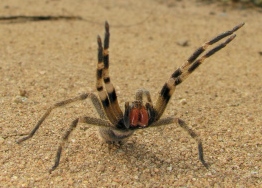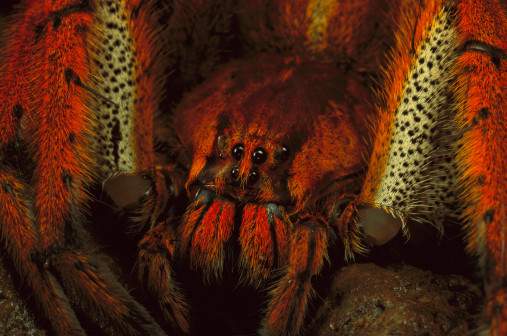Glossary
Book lungs: Respiration organ
used for gas exchange in arachnids. This organ
is found on the ventral side of the spider and
consists of stacks of air pockets and hemolymph-filed
tissue that makes them look like pages in a
book.
Calcium Ion Channels: A series
of proteins that are located along a nerve cell
which are selectively permeable and only allow
ions to pass through them thus allowing the
impulse to move down the nerve cell. The venom
from P. fera blocks these channels
which blocks nerve impulse from moving through
the cell and causing paralysis in the victim.
Chelicerae: A pair of
appendages in front of the mouth in arachinds
which have claws attached to them.
Copulation: A general term used
for the reproductive process whether it be
attracting a mate or the actual process of
sexual intercourse.
Dioecious: A term used to
describe a group of organisms in which there are
male and female species. If a species only
consists of hermaphroditic organisms it is
referred to as monoecious.
Dorsal: Referring to the upper
side or back of an animal, plant, or organ. The
dorsal side of your pet dog would be the side
that you pet when he’s standing up.
Ganglion: A cluster of nerve
cell bodies which are linked by synapses. In
more primitive organisms such as arachinds a
cluster of ganglion will serve as a brain for
the spider.
Hemolymph: The circulatory
fluid found in most organisms with open
circulatory systems. Hemolymph is the equivalent
of blood in humans. Blood is iron based however
whereas hemolymph is copper based.
Heterotrophic: A term used to
describe an organism that must obtain their own
food from an outside source and cannot make
their own food. Most plants are not considered
heterotrophic because they can make their own
food through photosynthesis.
Molt: Shedding of the
exoskeleton allowing the organism to grow. This
process is performed by arthropods as well as
nematodes.
Pedipalps: A pair of appendages
attached near the mouth of arachnids that have
various functions such as manipulating food they
are about to eat, various reproductive purposes,
or sensory functions.
Predation: The act of feeding
on other animals as a means of food source.
Serotonin receptors: Proteins
located on the surface of nerve cells which bind
to serotonin and allow the chemical to function.
The venom of P. fera is known to
stimulate these receptors causing great pain in
the victim.
Striated: Describing a type of
muscle that is characterized by linear marks.
Striated muscle tissue is usually multinucleated
and makes up skeletal and cardiac muscle.
Ventral: A term used to
describe the underside of an animal or organ. In
humans the ventral side consists of features
such as the face and abdomen muscles.
Back to top



